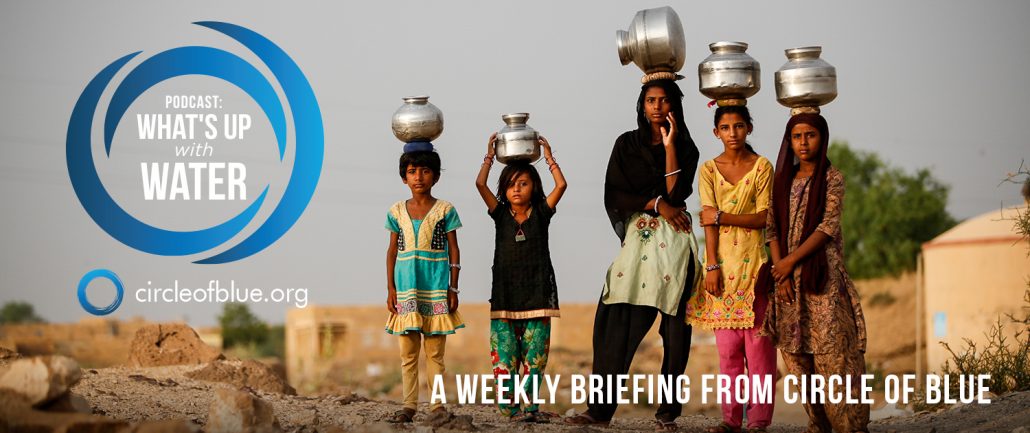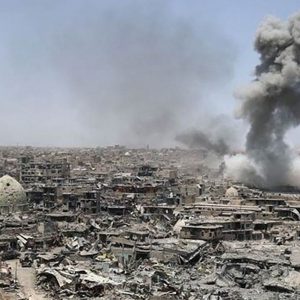
Transcripts
What’s Up With Water – July 16, 2018
I’m Eileen Wray-McCann, for Circle of Blue, and here’s What’s up with Water, your “need-to-know news” of the world’s water.
In western Japan, hundreds of thousands of people are struggling to cope with water outages, after one of the country’s worst rain-related disasters in decades. Devastating floods and landslides have killed over 200 people, with scores more still unaccounted for.
Hiroshima, Ehime and Okayama prefectures were hit hardest by the rains, with over 250 thousand homes lacking water. But Osaka, Yamaguchi and Tokushima are also relying on outside water supplies, with no estimate yet for when service might be restored. The damage includes burst water pipes, power outages and flooded water treatment facilities.
Takashi Okuma, an expert in natural disasters and professor emeritus at Niigata University, warns that authorities made urban development a priority without enough planning for emergency management. “Japan has built up the disaster prevention for quakes very well since the 1995 massive quake, but those for the water disaster hazard are very much behind,” he said. “This disaster will change that.”
In South Africa’s Western Cape, dam levels are rising steadily. The province’s largest dam contains nearly twice as much water as it did last year at this time. Much-needed rainfall has made a significant difference toward alleviating a severe three-year drought.
Despite the improvement, officials are retaining water restrictions of 50 litres per person per day until dam levels reach more than 85% as an average. The head of the Department of Water and Sanitation’s regional office said that climate change means that residents need to continue to save water and change the ways in which they use water. He added that government at all levels must work together to guard against complacency and towards better water security.
Circle of Blue’s Brett Walton has been following Cape Town’s water crisis, and has a comprehensive report on the challenges and responses to “Day Zero.” You’ll find it at circleofblue.org.
In Bangladesh, tanneries shut down for dumping toxic chemicals into one river are now poisoning another at a new industrial facility.
In the Dhaka neighborhood a year ago, there were over 150 tanneries processing leather, and the air and water were so toxic that environmentalists called it one of the most polluted places on the planet. The nearby Buriganga River, which supplies water for 180 thousand residents, was deemed poisoned. International condemnation moved the government to shut the tanneries in April 2017, ordering them to move to a new plant in Savar.
The Associated Press reports that factories at the new location are polluting the Daleshwari River and dumping toxic chemicals in open fields. The sewage treatment and effluent systems on site are inadequate for handling the waste. At the Savar facility, an AP reporter found that, contrary to official claims, the effluent treatment plant was not yet fully functional. In addition, there is a new threat: rains are causing repeated breaches in embankments around a solid waste pond, sending more pollution into the river.
The associate director of the environment program at Human Rights Watch said that people convinced themselves that the problem was technical, not political. But Bangladesh’s tanning industry, he said, will not reform until the government gets serious about enforcing laws. Many fear that relocating the tanneries has just moved an environmental disaster from one place to another.
In the United States, prolonged drought in the Southwest has water managers pressing for a region-wide plan for the Colorado River as historically dry conditions continue to deplete the watershed.
Lake Mead, the largest Colorado River reservoir, is about a foot and a half away from a level that triggers automatic water cutbacks.
Some 40 million people in seven states and Mexico depend on the Colorado River, which is governed by various international treaties, interstate agreements and court rulings. Arizona gets about 40 per cent of its water from Lake Mead, and is one of the states that stands to lose most by the emergency cutbacks. It is also the last of the basin’s states to develop a drought contingency plan. Various agencies in Arizona had squabbled over strategy, but the impending cutbacks and pressure from other states and the federal government prompted them seek common ground and commit to having a plan ready next year for the state legislature. A drought plan would have to determine where and how to reduce water use. Agriculture could be hardest hit, but other industries, including homebuilding, would be affected as well.
More people are moving to Arizona, despite the fact that most of the state is in a severe or extreme state of drought. Last year Maricopa County was the fastest-growing county in the United States.
The Salt River Project, one of Arizona’s largest utilities, says that despite the increasing number of people, efficiency efforts and strategic conservation – including smarter building practices – are showing results. The utility announced last month that its customers used a third less water compared to 1980, despite a doubling of population since then. The Salt River Project’s director of water strategy, Christa McJunkin, credited the success to a history of people making good decisions, from plumbing codes, to water storage and wastewater recycling. “But,” she said, “we can’t lose our vigilance.”
And that’s What’s Up With Water…We’d like you to share what’s up where you are – Tweet us with your water news: @circleofblue #whatsupwithwater.
Eileen Wray-McCann is a writer, director and narrator who co-founded Circle of Blue. During her 13 years at Interlochen Public Radio, a National Public Radio affiliate in Northern Michigan, Eileen produced and hosted regional and national programming. She’s won Telly Awards for her scriptwriting and documentary work, and her work with Circle of Blue follows many years of independent multimedia journalistic projects and a life-long love of the Great Lakes. She holds a BA and MA radio and television from the University of Detroit. Eileen is currently moonlighting as an audio archivist and enjoys traveling through time via sound.




